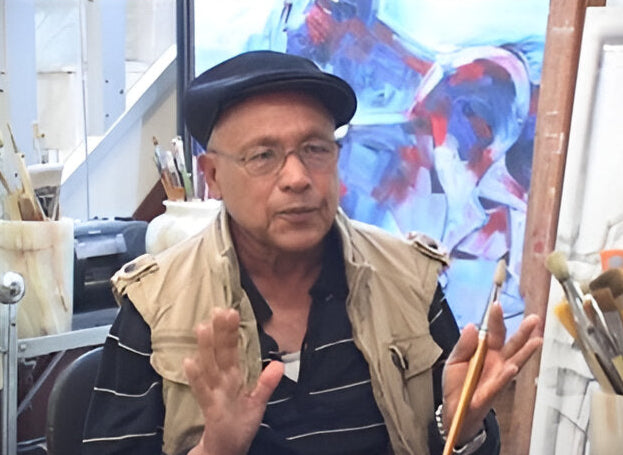
Mansoor Rahi
Mansoor Rahi, born in 1939 in Malda, West Bengal, India, is one of Pakistan's leading abstractionist painters. He is widely regarded for his contributions to the visual arts, particularly his ability to blend abstraction with representational forms. Over the years, his work has influenced a generation of Pakistani artists, both through his own artistic practice and his role as a teacher.
Early Life and Education
Rahi completed his early education at Rajshahi School in Dhaka. His passion for art led him to study at the prestigious Arts College in Dhaka, where he honed his skills. He later moved to Karachi in 1964, after his graduation, where he spent much of his career until 1983. It was in Karachi that he began to establish himself as a painter of note.
Artistic Development
Initially, Rahi’s works were inspired by impressionist techniques, with a focus on watercolour painting. However, as he continued his artistic journey, his style evolved. He began exploring cubism, which soon became a dominant feature of his early works. His exploration of cubism involved breaking down forms and reassembling them into fragmented planes, a technique that would become central to his visual language.
By the late 1960s, Rahi's style began to shift. When he moved to Islamabad, his thematic content became less focused on heavy, tragic themes, though these elements remained a part of his artistic expression. The peaceful mountain landscapes surrounding Islamabad also had a significant influence on his work, leading to a more tranquil aesthetic, although his work still carried deep philosophical and emotional undertones.
Influence of Terrorism
In later years, particularly in response to the growing wave of terrorism in Pakistan, Rahi's art began to reflect the turmoil and anguish he felt about the socio-political situation. His series "The Raging Bull” and “The Black Terror" are direct responses to the emotional and psychological toll that terrorism has had on him. These works have been well-received by both critics and the public for their powerful expression of these dark times.
Teaching Career
In the mid-1960s, Rahi moved to Karachi, where he met the Zuberi sisters, who were establishing the Karachi School of Art in Nazimabad. Recognizing his talent and experience, they invited him to become a teacher at the institution. Rahi eventually became the principal of the Karachi School of Art, and it was here that he mentored and influenced many young artists. His teaching legacy is significant, as he helped shape the careers of many renowned Pakistani artists.
Artistic Style and Series
Rahi’s work is a blend of abstraction and figuration, marked by a distinct representational quality despite its abstract nature. Some of his most well-known series include:
1. Grey Genesis Series
2. Wild Horse Series
3. World Food Crisis
4. Soul in Hell
5. Struggle for Achievement
These series reflect Rahi’s broad range of interests, from political and social issues to more personal explorations of the human condition.
Artistic Influences and Mentorship
Mansoor Rahi was influenced by some of the most prominent figures in the art world, including Mohammed Kibria and Abdul Razaq, who were his teachers. However, Zainul Abedin, the principal of the institute, left a lasting impression on him, shaping much of his artistic philosophy in the years to come.
Recognition and Awards
Throughout his career, Rahi has received numerous accolades, highlighting his outstanding contributions to the arts:
1. 1961: First Prize, Govt. College of Art & Craft, Dhaka
2. 1969: First Prize, All Pakistan National Exhibition (PNCA)
3. 1974: First Prize, Asian Art Expo, sponsored by ILO
4. 1981: First Prize, All Pakistan National Exhibitions (PNCA)
5. 1987: Shakir Ali Award, 1st International Biennale Show (PNCA)
6. 2008: Pride of Performance, awarded by the President of Pakistan
Legacy
Mansoor Rahi remains one of the most influential and celebrated artists in Pakistan. His work continues to inspire new generations of artists, and his impact on Pakistani art, both as a teacher and as a creator, is immeasurable. Rahi's ability to merge abstraction with poignant social commentary ensures that his paintings will remain relevant and revered for years to come.
